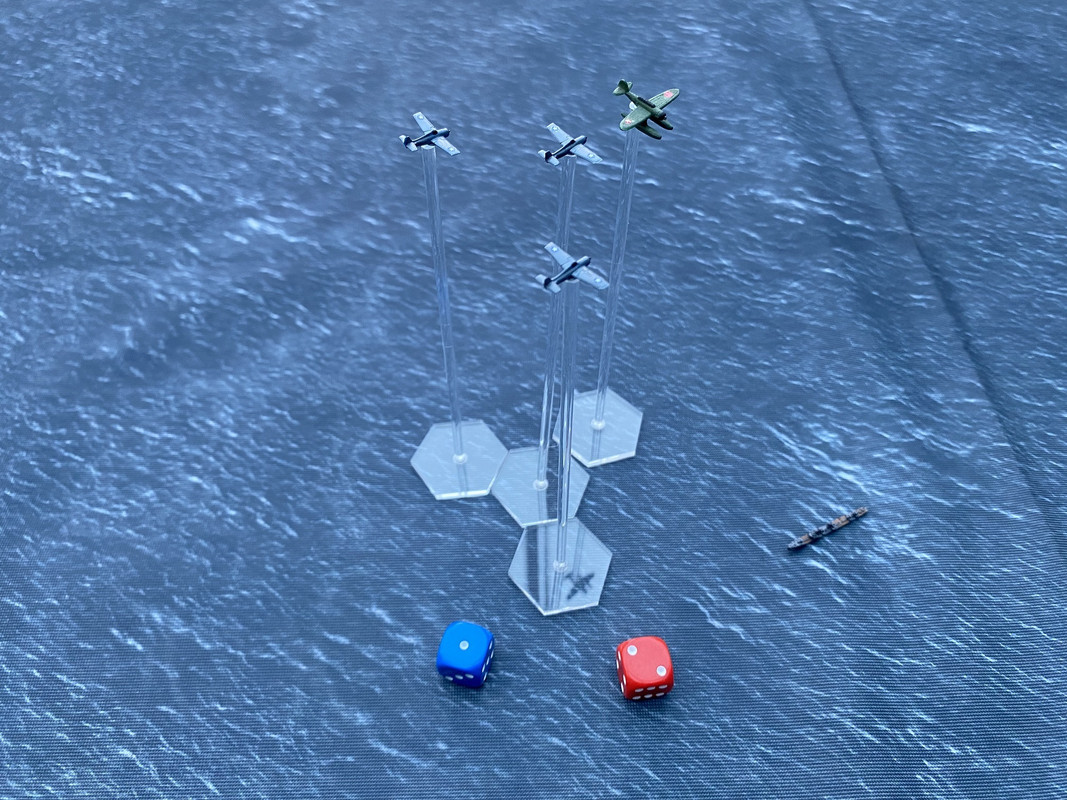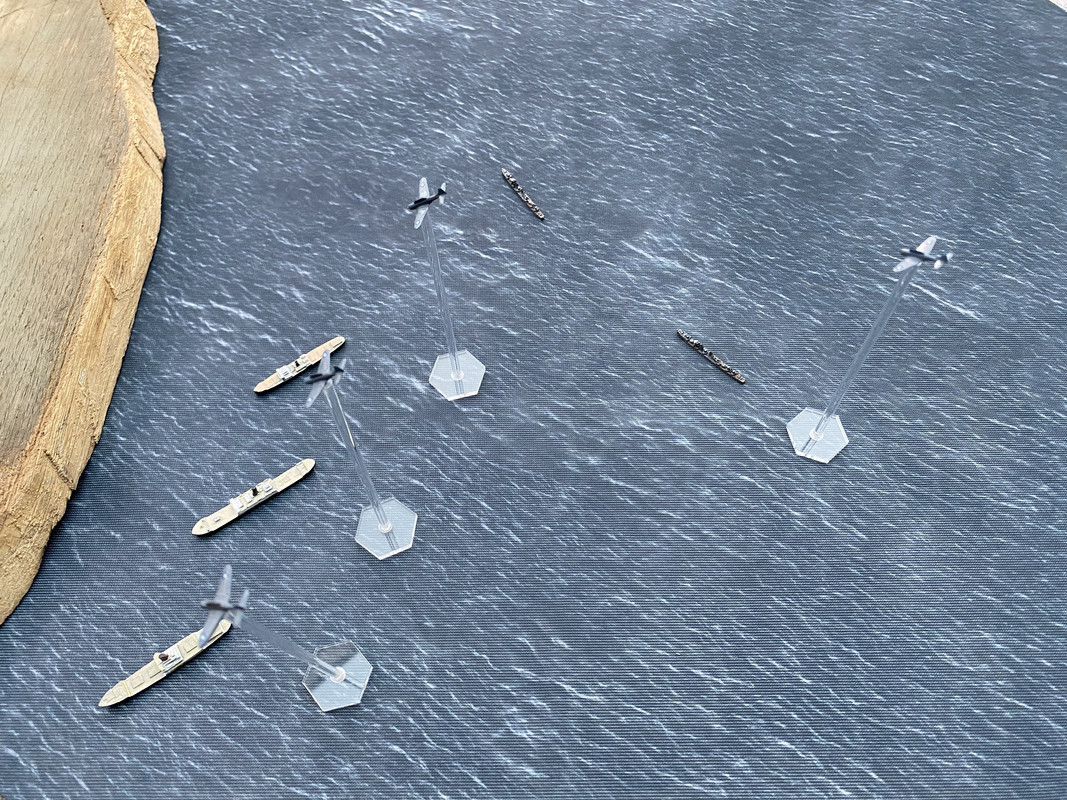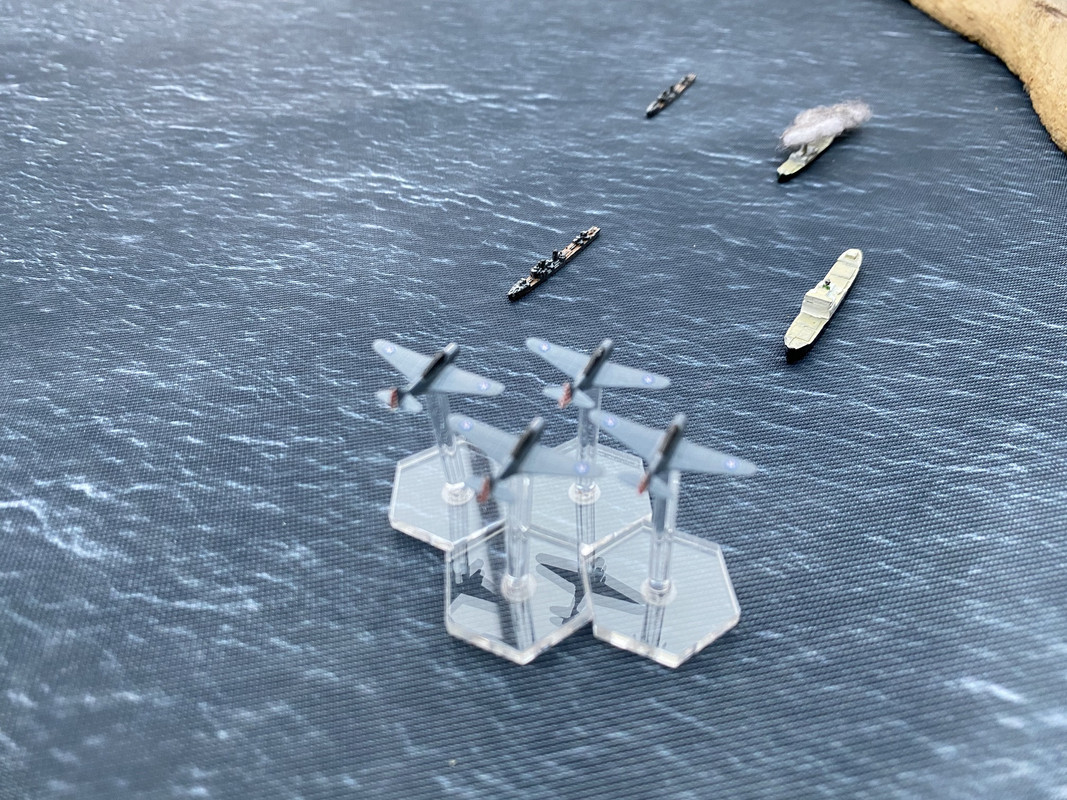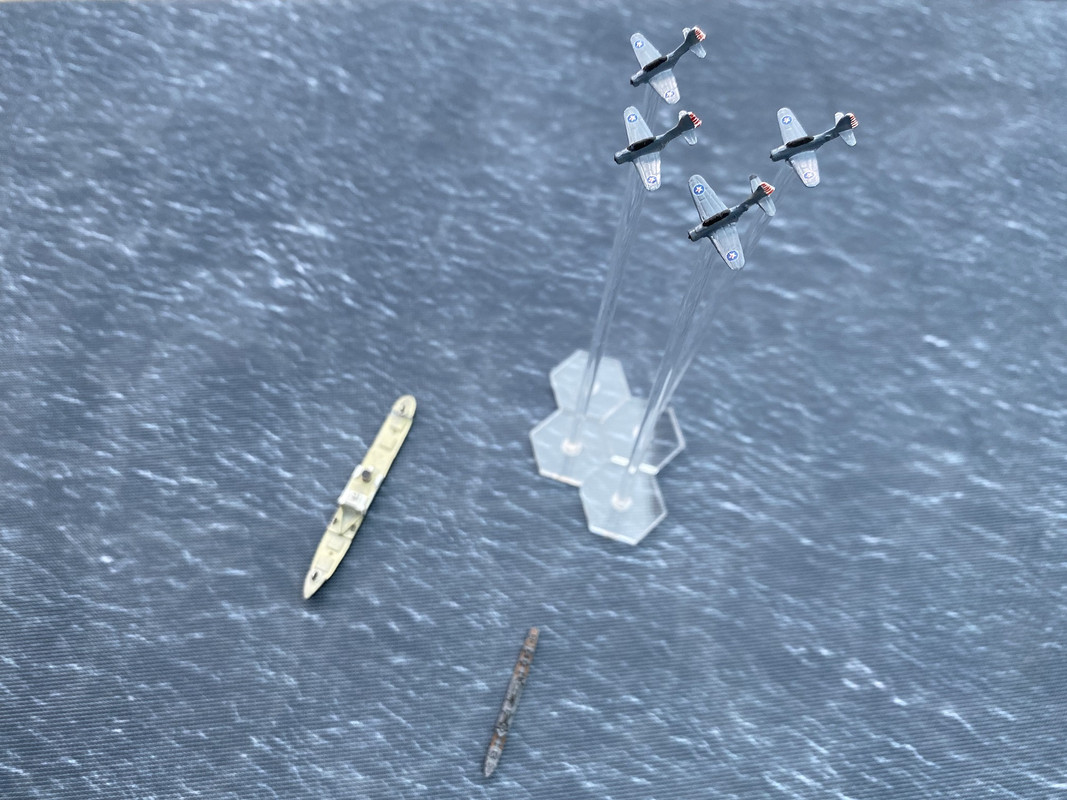Home › Forums › Air and Sea › Naval › The Lae and Salamaua raid, 10th March 1942
- This topic has 9 replies, 5 voices, and was last updated 1 month ago by
 kyoteblue.
kyoteblue.
-
AuthorPosts
-
18/05/2024 at 11:51 #198687
 AdmiralHawkeParticipant
AdmiralHawkeParticipantAs part of my Coral Sea campaign project, I wanted to see how the air strike rules in Find, Fix and Strike handle a large carrier operation. The Lae and Salamaua raid provides the perfect historical scenario, involving (not coincidentally) the two American carriers that would fight at the Battle of the Coral Sea two months later.
History
On March 8th, 1942, five transports of the Japanese South Seas Force land troops at Lae and Salamaua in Huon Gulf on the northern coast of Papua New Guinea, facing no resistance. The invasion is covered by elements of the Fourth Fleet, comprising the minelayer Tsugaru, the 6th Destroyer Flotilla with the light cruiser Yubari and six destroyers, and the seaplane carrier Kiyokawa Maru.
News of the landings prompts Vice-Admiral Wilson Brown, commanding two US carrier task forces operating in the Coral Sea, to change the objective of his planned carrier strike from Rabaul to Huon Gulf in the hope of catching Japanese ships off the beaches. To evade Japanese air searches covering the Solomon Sea, Brown takes his task forces south of the Papuan peninsula. On the morning of the 10th, the US carriers Lexington and Yorktown send their air groups to attack the Japanese landings in northern New Guinea from a flying-off position just 45 miles south of the Papuan peninsula.
The two carriers fly off 104 aircraft, which fly over the 13,000-ft Owen Stanley Mountains to attack the Japanese landing forces off Lae and Salamaua.Game set up
– I used Find, Fix and Strike rules (https://www.wargamevault.com/product/243377/Si-Vis-Pacem?) , which I have reviewed here (https://www.thewargameswebsite.com/forums/topic/a-review-of-find-fix-and-strike-naval-wargaming-rules/).
– The 1/3000 merchant ship miniatures and the Tsugaru are Davco miniatures from Navy Models & Books (https://navymodelsandbooks.co.uk/product-category/davco-13000/). The Yubari and the destroyers are from Tiny Thingamajigs on Shapeways (https://www.shapeways.com/designer/matt_atknsn). The 1/700 aircraft are a mix of Fujimi and Trumpeter.
– The mat is the dark sea mat from Tiny Wargames (https://www.tinywargames.co.uk).Battle

Lexington’s Air Group 2 (CVG-2) arrives over Huon Gulf having flown over the Owen-Stanley Mountains. They immediately spot numerous Japanese ships scattered along and just off the coast while a few Japanese float planes (from the seaplane carrier Kiyokawa Maru) patrol back and forth overhead. The Japanese are taken completely by surprise.
The Grumman F4F Wildcats of Fighting Three (VF-3) led by Lieutenant-Commander Thach spot some Japanese float planes and peel off to attack them. Despite outnumbering the slower and less manoeuvrable float planes, the Wildcats only succeed in driving off the float planes, failing to shoot them down.
Lieutenant-Commander Robert E. Dixon orders six Douglas SBD Dauntlesses from Scouting Two (VS-2) to dive bomb what he believes are two Japanese heavy cruisers, but are actually the minelayer Tsugaru and the light cruiser Yubari. Yubari and Tsugaru open fire on the Dauntlesses with their anti-aircraft guns: Yubari successfully drives off the flight of Dauntlesses attacking her; Tsugaru’s anti-aircraft gunnery has no effect. The Dauntlesses dive down towards Tsugaru, scoring hits that cause heavy damage to the minelayer.
As the Yubari’s gunners engage the Dauntlesses from Scouting Two, Lieutenant-Commander James H. Brett leads the Douglas TBD Devastators of Torpedo Two (VT-2) in a hammer-and-anvil torpedo attack on the light cruiser. There is no anti-aircraft fire.
The Devastators successfully hit the Yubari, flagship of Rear-Admiral Kajioka, with a torpedo. However the effect of the torpedo is disappointing, inflicting only light damage on the light cruiser.
The torpedo attack on the Tsugaru by the other six Devastators of Torpedo Two misses.
Dixon leads the remaining Dauntlesses of Scouting Two (VS-2) towards Lae to dive bomb the Japanese transports there. As they approach the Dauntlesses are engaged by the destroyer Mutsuki’s anti-aircraft guns, which damage one of the flights. The Dauntless flights split up and dive down on four different targets. The Dauntlesses cause light damage to the Kongo Maru, Kokai Maru and the Mutsuki, but miss the Tenyo Maru.
Lieutenant-Commander Weldon L. Hamilton leads the Douglas SBD Dauntlesses of Bombing Two (VB-2) south to Salamaua to attack the Japanese transports Yokohama Maru and China Maru which are unloading at anchor off the harbour. The destroyers Asanagi and Oite fire at the Dauntlesses, but have no effect. The Dauntless concentrate on the transports. The China Maru is crippled by a series of hits, while the Yokohama Maru escapes with light damage.Almost as suddenly as they had arrived, the attack is over and Lexington’s air group is flying back over the jungle towards the Owen-Stanley Mountains. The Lexington’s aircraft have hit the light cruiser Yubari with a torpedo, but only caused light damage, heavily damaged the minelayer Tsugaru, crippled the transport China Maru, and caused light damage to the destroyer Mutsuki and the transports Yokohama Maru, Kongo Maru and Kokai Maru. None of the Japanese ships have actually been sunk.
More later…
Yorktown’s Air Group Five (CVG-5) now arrives.
The Devastators of Lieutenant-Commander Joe Taylor’s Torpedo Five (VT-5) are armed with bombs, rather than torpedoes.

They sweep in over Salamaua to attack the Japanese transports, where the crippled China Maru is already burning from the Lexington’s strike. One of the flights is distracted by the anti-aircraft fire from the destroyers. Their bombs all miss. (I made a mistake here in using the rule for high-level, rather than low-level, bombers. None of the flights achieved a 5+.)
Dauntlesses from Lieutenant-Commander Robert G. Armstrong’s Bombing Five (VB-5) dive bomb the burning minelayer Tsugaru, which is almost concealed by smoke, and the light cruiser Yubari. As the Dauntlesses dive down on Tsugaru, they are fired upon by the destroyer Yunagi’s anti-aircraft guns, but these have no effect. Bombs rain down around Tsugaru, with several hitting, crippling and then silencing the minelayer. (In Find, Fix and Strike, further heavy damage to a ship that is already ‘crippled’ results in it being ‘silenced’.)
The light cruiser Yubari, flagship of Rear-Admiral Kajioka, comes under attack from two other flights from Bombing Five (VB-5). Her anti-aircraft fire distracts one of the flights. The Dauntlesses dive down on Yubari, with both flights inflicting light damage. As the Yubari is already lightly damaged, she is now heavily damaged.
The other Dauntlesses from Bombing Five attack the Japanese transports Kongo Maru and Kokai Maru off Lae, which have both already been damaged by the earlier attack by Scouting Two. Tenyo Maru is leaving the harbour. The Dauntlesses score another hit on the Kokai Maru, which is now heavily damaged, but miss the Kongo Maru.
Meanwhile, Lieutenant-Commander William O. Burch leads the Dauntlesses of Scouting Five (VS-5) towards a large merchantman, escorted by a destroyer, which the Dauntlesses have spotted further along the coast. This is actually the Japanese seaplane tender Kiyokawa Maru with the destroyer Mochizuki.
The Wildcats of VF-42 led by Lieutenant-Commander Oscar Pederson engage the Japanese float planes, finally destroying them.
Dauntlesses of Scouting Five (VS-5) now attack the seaplane carrier Kiyokawa Maru. As they approach, the Dauntlesses are engaged by destroyer Mochizuki, which succeeds in driving off one of the Dauntless flights. Hit at least twice by the Dauntlesses, the Kiyokawa Maru is heavily damaged.Outcome
Lexington’s Air Group 2 has crippled the transport China Maru, heavily damaged the minelayer Tsugaru, hit the light cruiser Yubari with a torpedo, but only caused light damage, and caused light damage to the destroyer Mutsuki and the transports Yokohama Maru, Kongo Maru and Kokai Maru.
Yorktown’s Air Group 5 has inflicted further damage on Tsugaru, silencing but not sinking her, heavily damaged Kiyokawa Maru and further damaged both Yubari and Kokai Maru so that both ships are now heavily damaged.
Two entire carrier air groups have failed to sink a single ship.Historical comparison
Historically, the Americans sank the armed merchant cruiser Kongo Maru and the transports Tenyo Maru and Yokohama Maru. The cruiser Yubari, minelayer Tsugaru, destroyers Asanagi and Yunagi, two transports and two auxiliaries were damaged.
Although the Pacific Fleet staff were disappointed with the result at the time, and Admiral King recalled Vice-Admiral Brown, the raid severely disrupted Japanese operations in the South-West Pacific, prompting Vice-Admiral Inoue to call for carrier support for the next phase of operations. Further Japanese operations were postponed until carrier support could arrive in early May 1942.20/05/2024 at 19:05 #198791 Darkest Star GamesParticipant
Darkest Star GamesParticipantThat looked pretty good as far as games go, and a plausible outcome. How do you feel about it?
(and the minis on the tabletop looks great too!)
"I saw this in a cartoon once, but I'm pretty sure I can do it..."
21/05/2024 at 16:51 #198823 hammurabi70Participant
hammurabi70ParticipantExcellent write-up. Giving the brief details on rules, troops and terrain is very helpful to anyone who wants to do something similar.
Looking forward to the More later … !
www.olivercromwell.org; www.battlefieldstrust.com
6mm wargames group: [email protected]; 2mm wargames group: [email protected]26/05/2024 at 13:33 #198953 AdmiralHawkeParticipant
AdmiralHawkeParticipantThat looked pretty good as far as games go, and a plausible outcome. How do you feel about it? (and the minis on the tabletop looks great too!)
Excellent write-up. Giving the brief details on rules, troops and terrain is very helpful to anyone who wants to do something similar. Looking forward to the More later … !
Thank you both. 🙂
I have now added the second part of the raid, by Yorktown’s air group.
Overall, I’m pleased with it:
- I think the trompe l’œil or optical illusion of 1/700 aircraft and 1/3000 ships works.
- I like that Find, Fix and Strike lets you conduct aerial attacks on ships on the table top.
- The outcome was mostly historically plausible, as you say, if disappointing from an American perspective. But two carrier air groups failing to sink anything doesn’t quite ring true (though the Tulagi raid of 4th May nearly failed to sink anything).
- So I do have a few more reservations about how the rules work now.
27/05/2024 at 21:58 #198981Levi the Ox
ParticipantInteresting, thanks for sharing!
It looks like damage is inflicted in steps, which might make destruction unlikely from any single attack in this system. Is there perhaps a mechanic for damage control or progressive damage from fires and flooding? Tsugaru has taken so much punishment she seems likely to sink sometime after the raid has departed, and the crews of the heavily damaged transports might well not be able to control fires or flooding either.
28/05/2024 at 15:47 #199009 Darkest Star GamesParticipant
Darkest Star GamesParticipantI would think that you might want to step the damage from air attacks based upon the historical weapons loadout of the aircraft. For example, the rules may not say that CAP aircraft can attack ships but we know they often strafed them. So, fighters with up to .50cals couldn’t cause anything more than Light Damage (nor send ships beyond that threshold) whereas maybe a Dauntless dropping at 1000lb would skip the Light Damage condition and go straight to heavy damage? Planes that have 500lb bombs would still start at Light Damage, etc.
Oooo, this could allow you to have those A26s and B25s with the 75mm canon for raids against shipping as well as KI-45!
"I saw this in a cartoon once, but I'm pretty sure I can do it..."
07/06/2024 at 20:06 #199385 AdmiralHawkeParticipant
AdmiralHawkeParticipantIt looks like damage is inflicted in steps, which might make destruction unlikely from any single attack in this system. Is there perhaps a mechanic for damage control or progressive damage from fires and flooding?
Yes. That’s exactly right: damage is inflicted in escalating steps. There is special damage, incurred when the defending ship rolls a one, but no other progressive damage. It’s a fast-play system.
I would think that you might want to step the damage from air attacks based upon the historical weapons loadout of the aircraft. For example, the rules may not say that CAP aircraft can attack ships but we know they often strafed them. So, fighters with up to .50cals couldn’t cause anything more than Light Damage (nor send ships beyond that threshold) whereas maybe a Dauntless dropping at 1000lb would skip the Light Damage condition and go straight to heavy damage? Planes that have 500lb bombs would still start at Light Damage, etc.
Yes. I think the air attacks should probably be a little more punishing. And you are quite right about Wildcats with .50cals inflicting lots of light damage.
Part of the problem is the way damage is calculated. The mechanic of attacking aircraft having to score double, triple or quadruple the ship’s score limits the outcomes more than simply having to score 3, 4, 5 or 6 more than the ship’s score would.
07/06/2024 at 20:14 #199388 AdmiralHawkeParticipant
AdmiralHawkeParticipantRules reflections
No set of wargame rules is perfect, and nor is any player. I know I made a few mistakes, and I probably made a couple of others that I have not yet realized. That said, three events in the game struck me as historically possible but unlikely outcomes: a half-squadron of Wildcats struggling to shoot down some float planes, a torpedo hit causing only light damage to a light cruiser, and two carrier air groups failing to sink a single ship. None seemed to be chance outcomes from a single lucky or unlucky die roll. So I dug into the game mechanics to see whether these are unlikely or likely outcomes in the game.Fighter effectiveness
Air combat in Find, Fix and Strike uses opposing die rolls, which is more intuitive for air-to-air fighting than it is for gunnery, and the same results table as anti-aircraft fire. This seems efficient, but the table does not seem lethal enough for air combat (while being too effective for AA). Because flights of aircraft need to triple the opposing aircraft’s score to shoot them down, a flight of F4F Wildcats has only a 25% (9 in 36) chance of destroying a flight of float planes like the Aichi E13A in the first round of combat. Against a flight of Nakajima B5N torpedo bombers or Aichi D3A dive bombers, a flight of Wildcats has only a 8% (3 in 36) chance of destroying the enemy aircraft in the first round of combat, with a further 17% chance of driving them off (6 in 36). A flight of Wildcats cannot shoot down a flight of A6M Zeros in a single attack because it is impossible to triple the A6M’s air-to-air (A2A) factor of three, plus a minimum roll of one, whatever the Wildcats’ die roll. The best Wildcats can achieve against A6M Zeros is a damaged result, needing another damaged result in a second round of combat to destroy a flight of A6Ms.
So I’m wondering how effective a combat air patrol is going to be against an incoming strike. I need to research how effective defending fighters actually were in the Pacific in 1942. Offsetting the relatively low effectiveness of defending fighters in a single pass, combat-air-patrol flights do get two attacks against strike aircraft if no escorting fighters are present. There is no allowance in the rules for the type of radar-directed fighter inception that the fighter direction officers aboard British carriers mastered during 1940 and 1941 and the Americans mastered during the course of 1942.Torpedo damage to light cruisers
The torpedo rules are the least-well written and tested part of Find, Fix and Strike. Achieving a torpedo hit in the first place is difficult, as it should be, needing a roll of 11+ on two dice (2D6). Having achieved a hit, you then have to calculate the damage caused. Rather than a simple die roll, this uses the opposing die roll mechanic, adding additional calculations. Most aircraft torpedoes use an attack factor of three, while most cruisers and carriers have a defence factor of two. That means that a torpedo hit, not a torpedo attack, has no chance of sinking a cruiser or carrier outright, only a one in 36 chance of crippling a cruiser or carrier (2.7%), a five in 36 chance of causing heavy damage (14%), and 15 in 36 chance of causing light damage (42%) and the same chance of having no effect at all (42%). So the most likely outcome of a torpedo hit on a cruiser (or carrier) is either light damage or no effect at all. There’s also a one in six chance of special damage if the ship rolls a one, which might result in a fire or a magazine explosion.
It’s hard to think of a single instance in the Second World War where a light cruiser was lightly damaged by a torpedo. Light cruisers that were hit by a torpedo either sank (e.g. Karlsruhe, Helle, Calypso, Bonaventure, Galatea, Naiad, Hermione, Cairo, Juneau, Dunedin, Penelope and Yubari) or, at best, were heavily damaged and under repair for six months or more (e.g. Leipzig, Raleigh, Naka, Argonaut, Cleopatra, Leander). About the only instance I can find of (relatively) light torpedo damage to a light cruiser was when the Japanese cruiser Agano was hit by an airborne torpedo on the extreme stern at Rabaul in November 1943.
As it happens, American torpedoes were largely ineffective in 1942, owing to undiagnosed design flaws. But that isn’t what the rules are modelling (unlike Sam Mustafa’s Nimitz, which does model this). So either I have misunderstood the torpedo rules or they are flawed. I will devise something else.Sinking ships by air attack
A fundamental design requirement of any game of the carrier battles of 1942 is that Douglas SBD Dauntlesses have to be able to sink Japanese carriers, which they did six times in the course of 1942. Similarly, the Aichi D3A Type 99 and Nakajima B5N Type 97 need to be able to sink American carriers, which they did, more or less, three times in 1942. The existence of the ‘crippled’ and ‘silenced’ damage levels in Find, Fix and Strike makes ships very hard to sink. The concept of crippled and silenced makes sense for gunnery damage where big guns could destroy the superstructure of a ship without greatly impairing the buoyancy of the hull. Crippled and silenced make less sense for bomb or torpedo damage which could and did destroy the watertight integrity of ships.
Strike aircraft in Find, Fix and Strike might have an attack factor of two or, in exceptional cases like the SBD Dauntless that could carry a 1,000-lb bomb, three. Each flight of aircraft adds its die roll to the aircraft’s attack factor, while the ship being attacked adds its die roll to its defence factor. The aircraft has to double the ship’s score to inflict heavy damage, triple it to cripple the ship, and quadruple it to sink it. That means that a flight of aircraft with an attack factor of three can only sink a ship with a defence factor of one (like a transport or a destroyer) if the aircraft rolls a 5 or 6 and the ship rolls a 1, which is two chances in 36, or about 5%. A flight of aircraft with an attack factor of three cannot sink a ship with a defence factor of two (like a cruiser or a carrier); the aircraft have a one in 36 chance of crippling the ship (2.7%), a five in 36 chance of causing heavy damage (14%), and 15 in 36 chance of causing light damage (42%) and the same chance of having no effect at all (42%). So, as written, it’s impossible to repeat the feat of the flight of Dauntlesses flown by Lieutenant Dick Best and his two wingmen, which doomed the Akagi with a single bomb hit and two near misses.
I think the answer is just to treat the ‘crippled’ result as sunk, or doomed to sink.10/06/2024 at 17:18 #199476 Darkest Star GamesParticipant
Darkest Star GamesParticipantGreat insights on the mechanics.
Using Crippled as Sunk in relation to torpedo hits looks like a good solution on paper, and probably better than upping the aircraft attack numbers which could change the balance too much. The deal with the fighters feels weird. Maybe shifting to using D8s for fighters would work better?
"I saw this in a cartoon once, but I'm pretty sure I can do it..."
11/08/2024 at 05:54 #201432 kyoteblueParticipant
kyoteblueParticipantI’m glad I found this thread.
-
AuthorPosts
- You must be logged in to reply to this topic.

